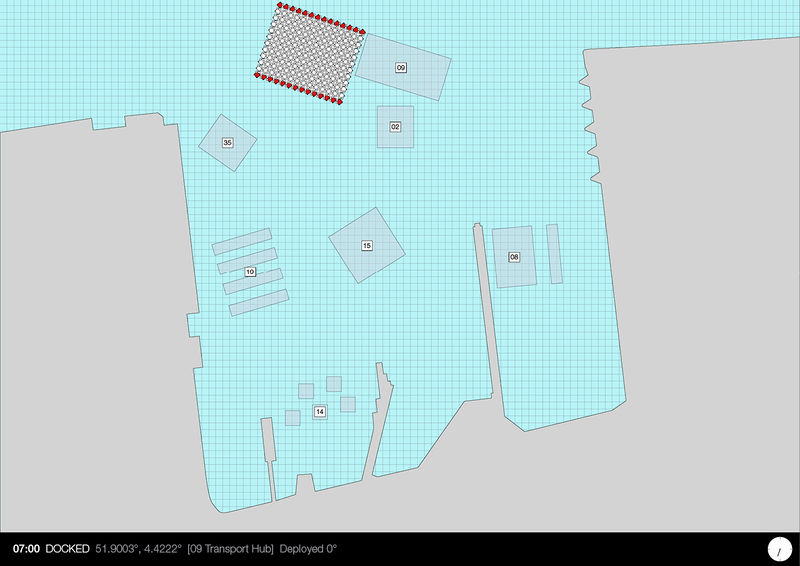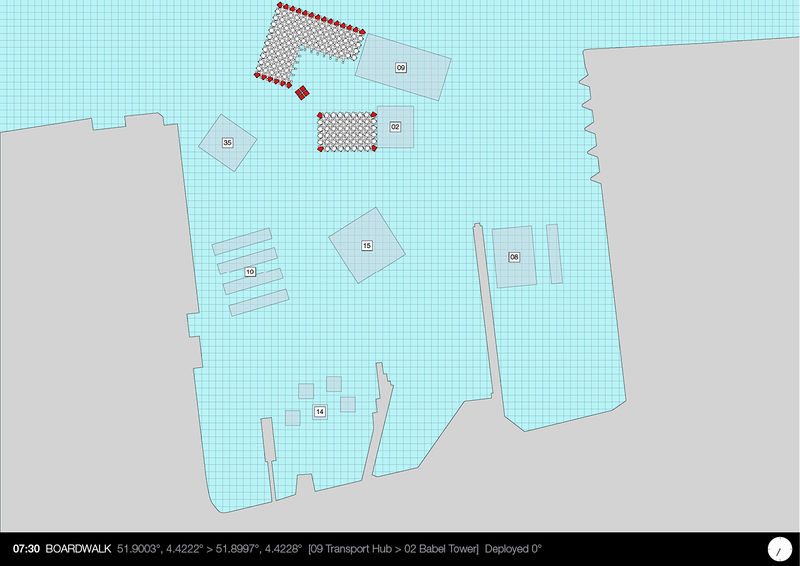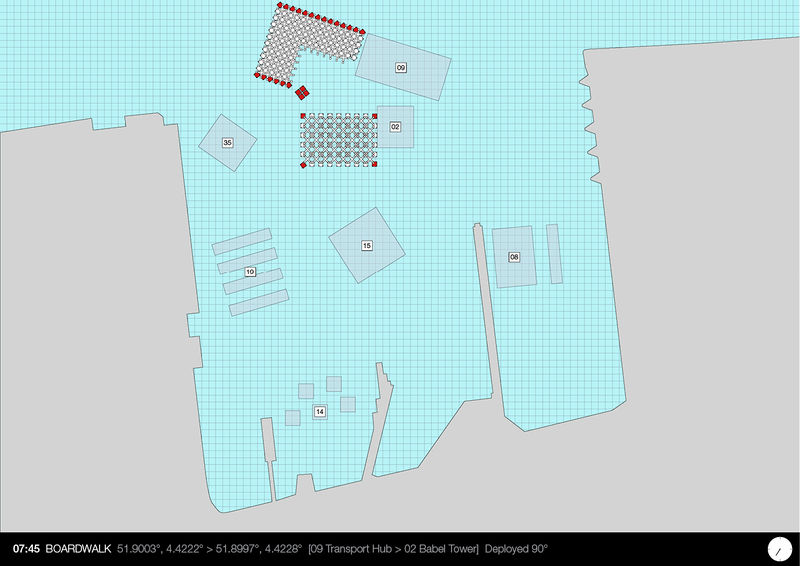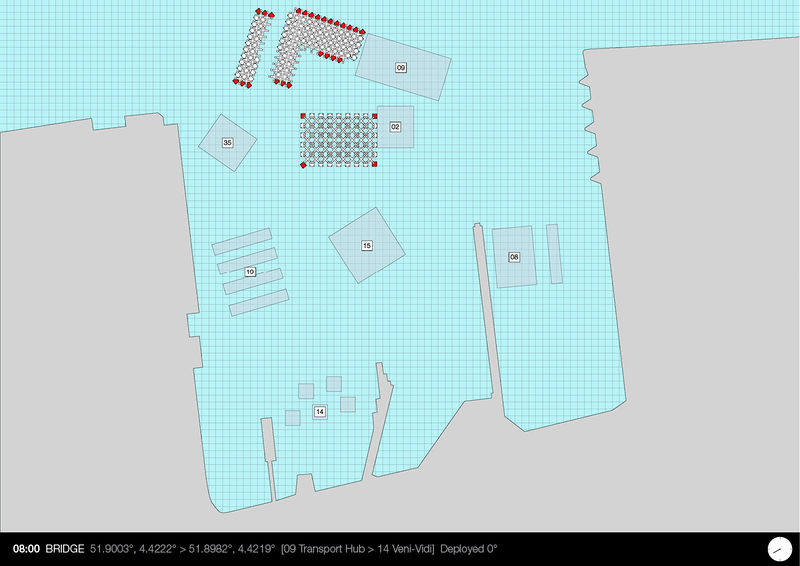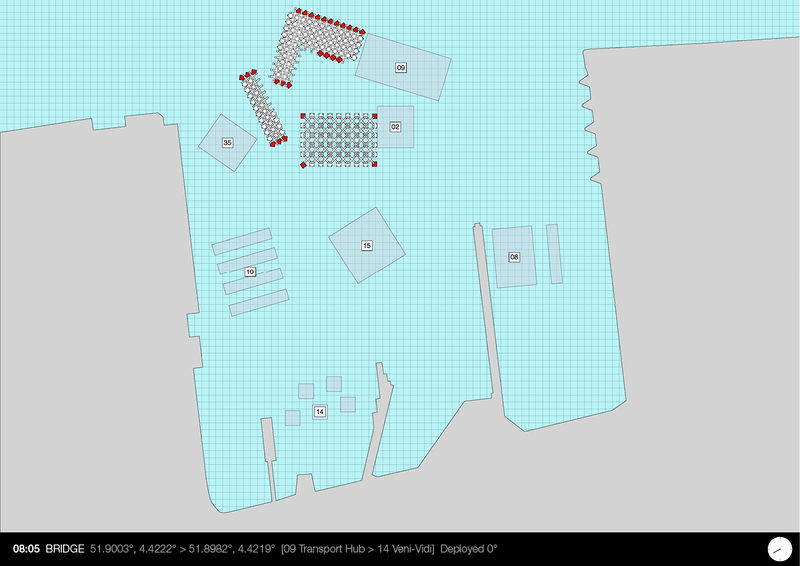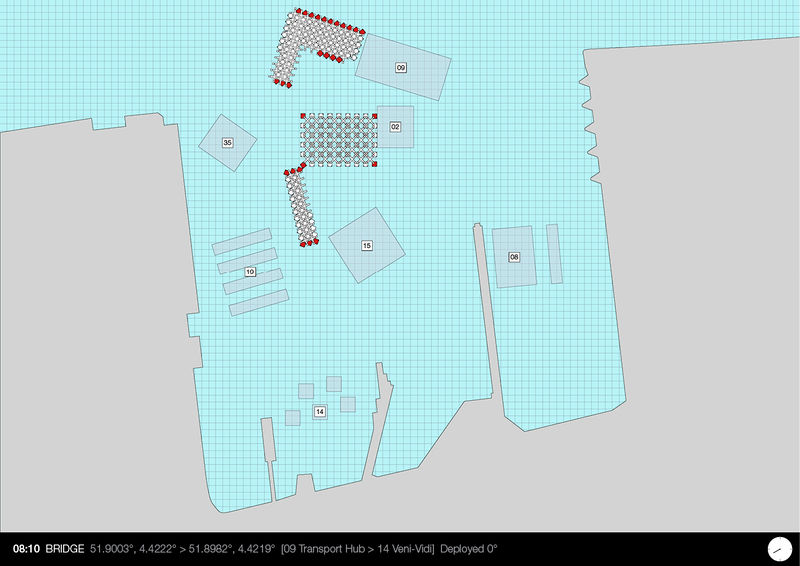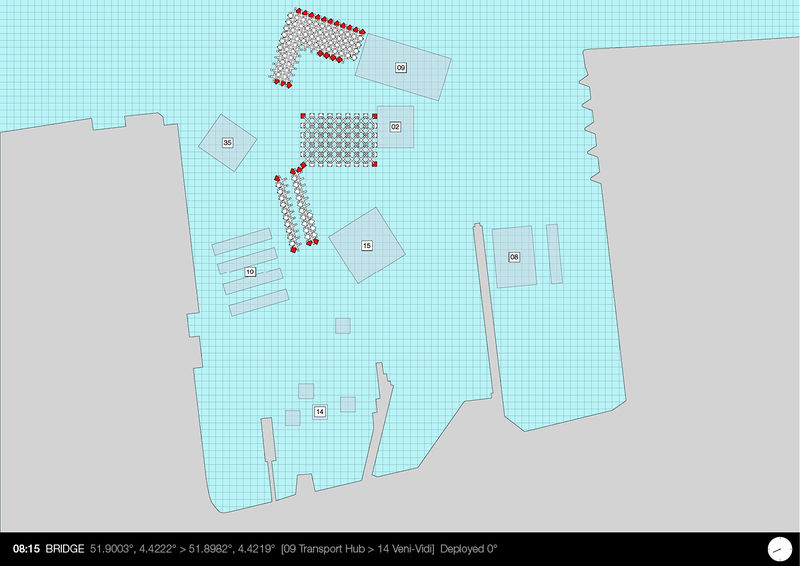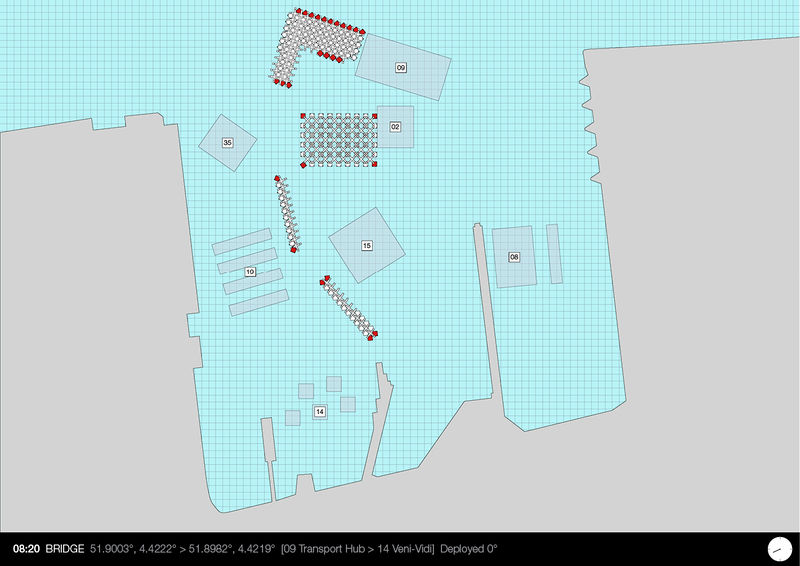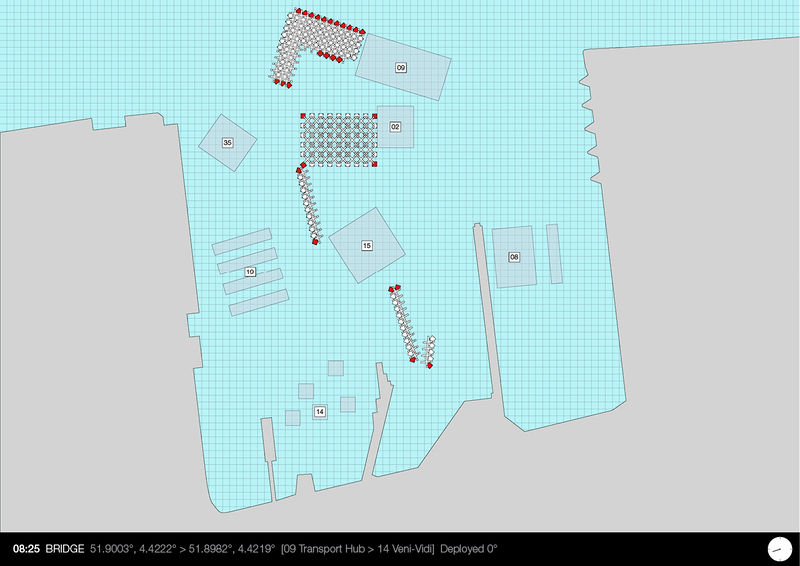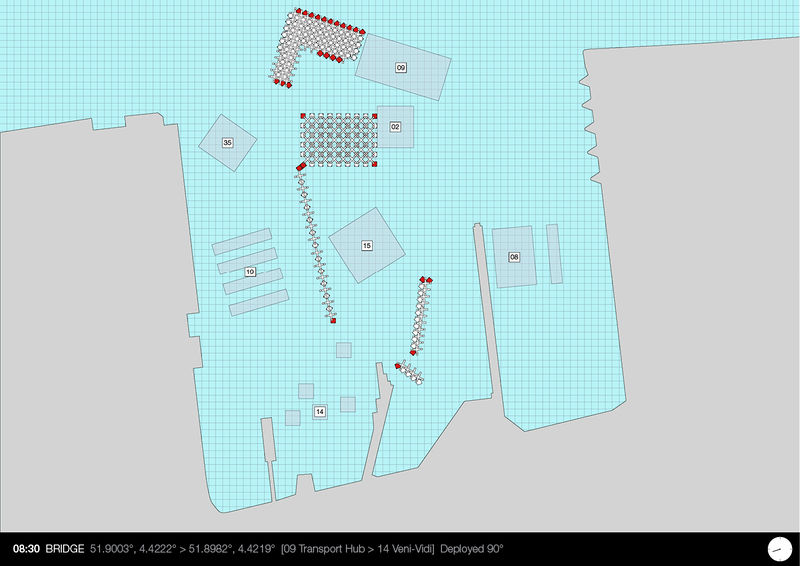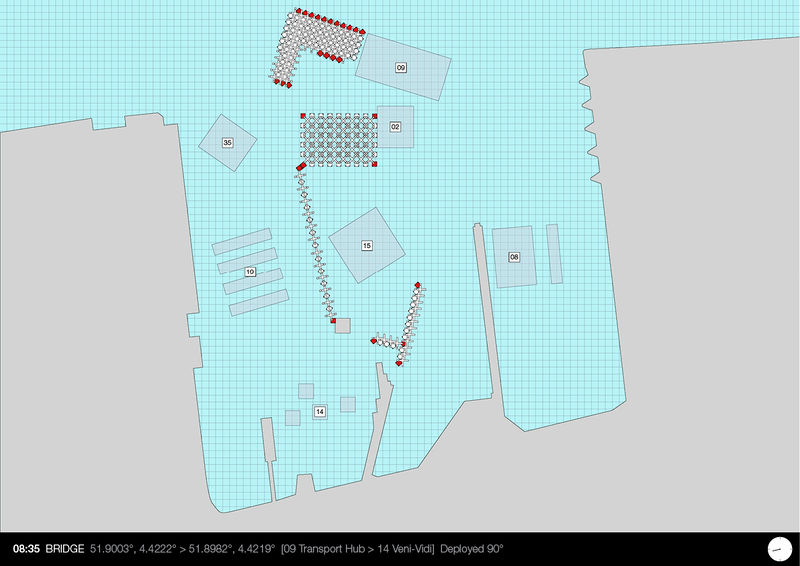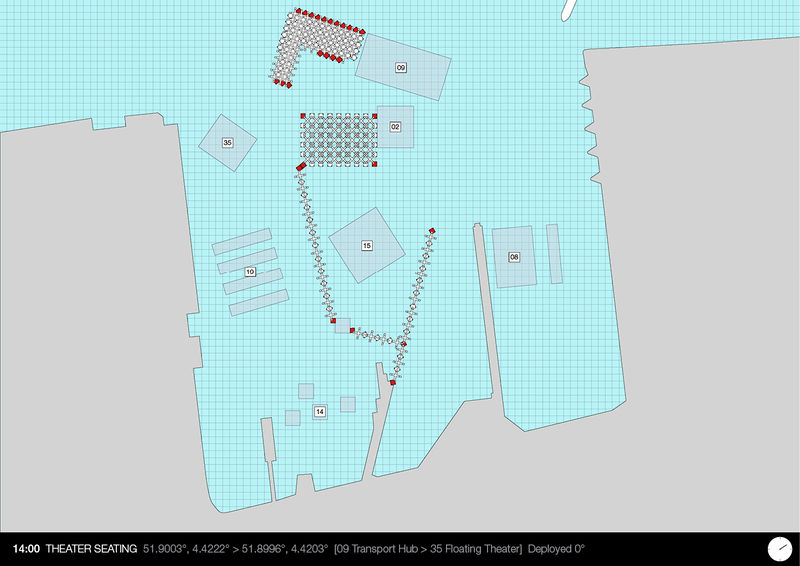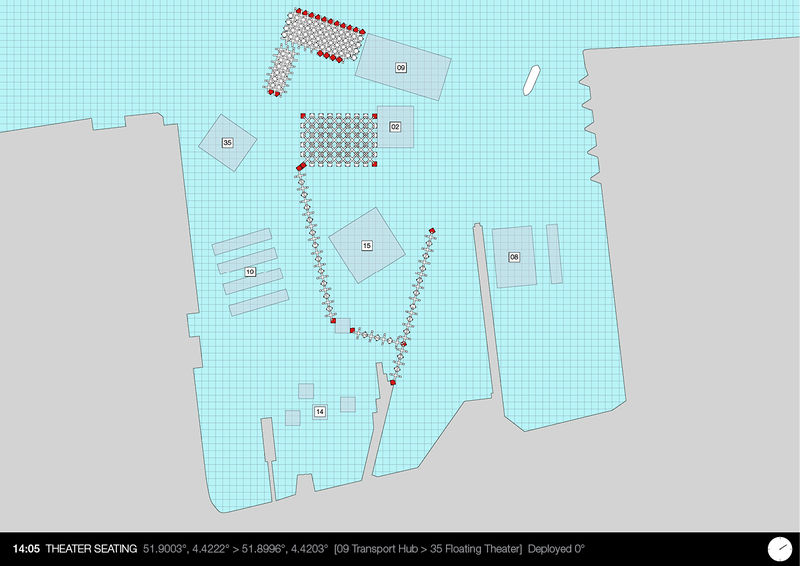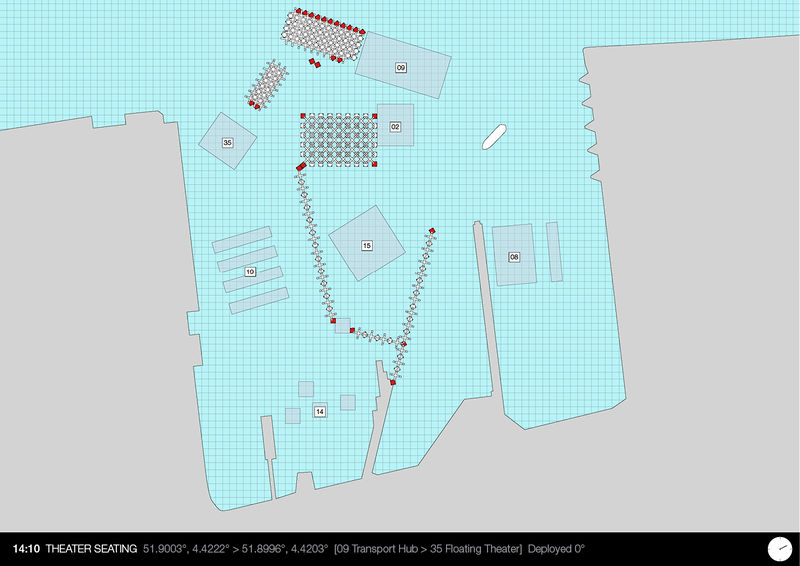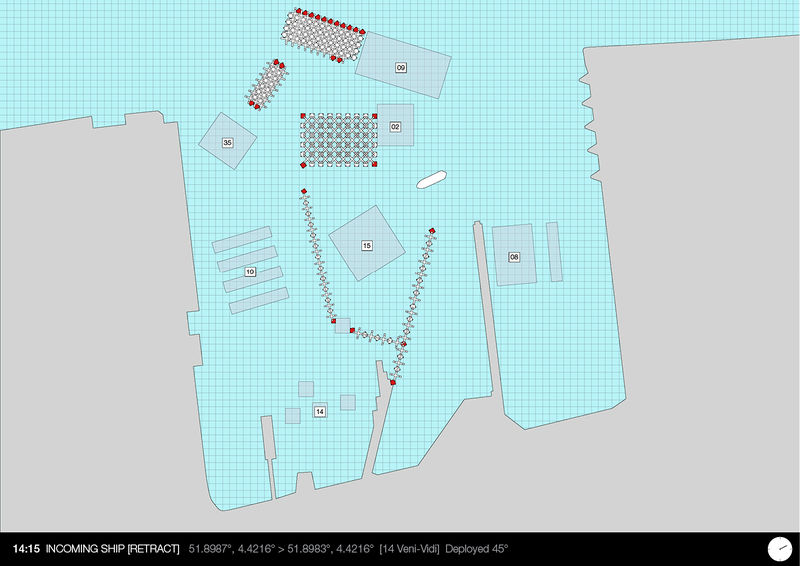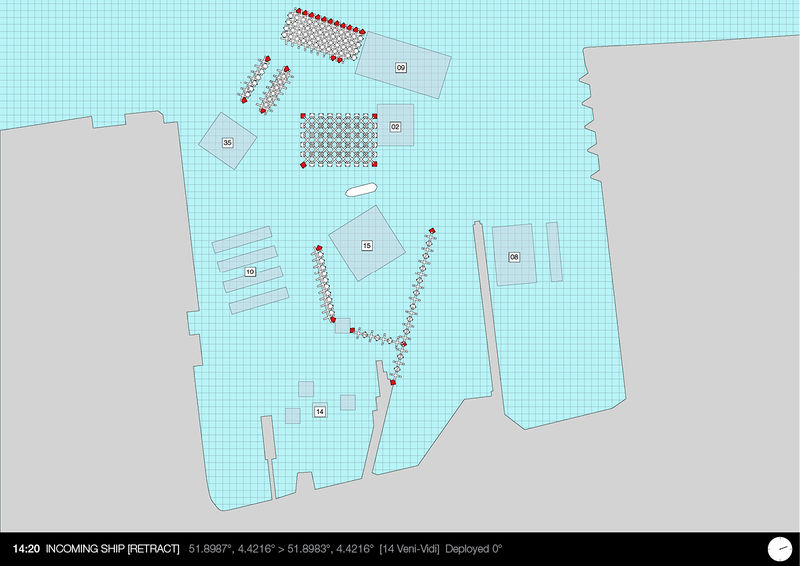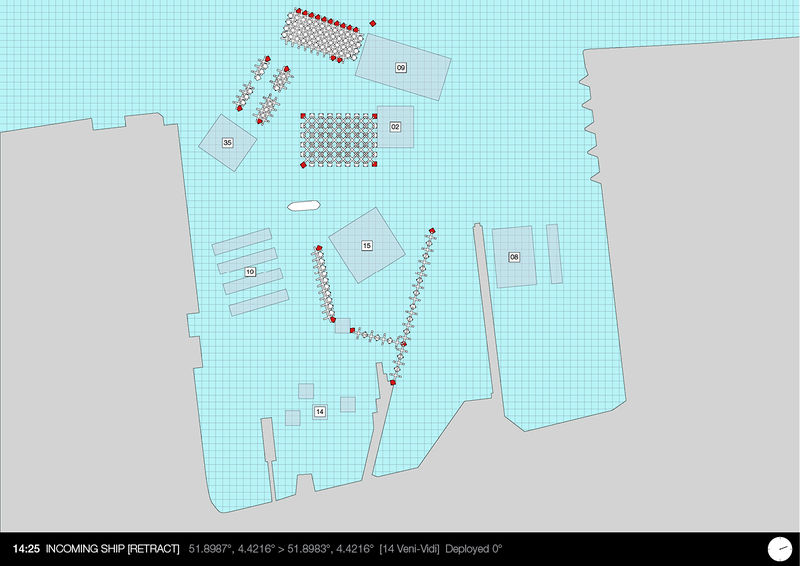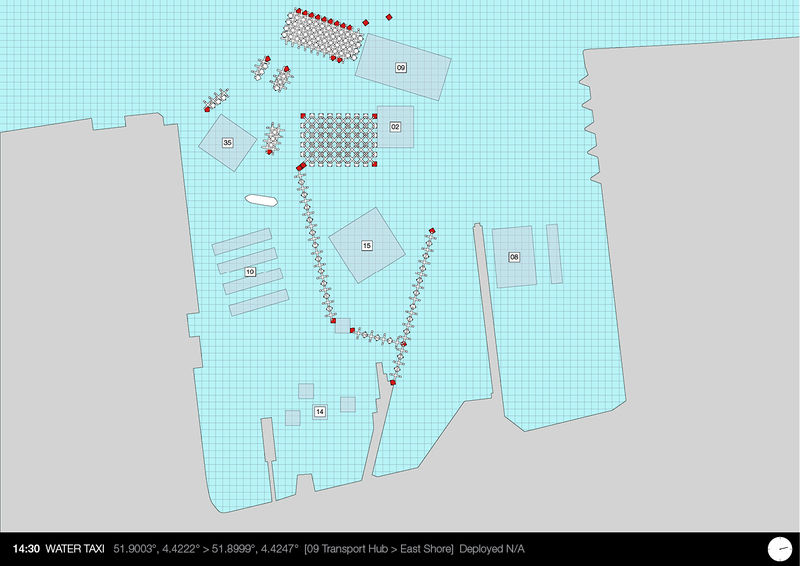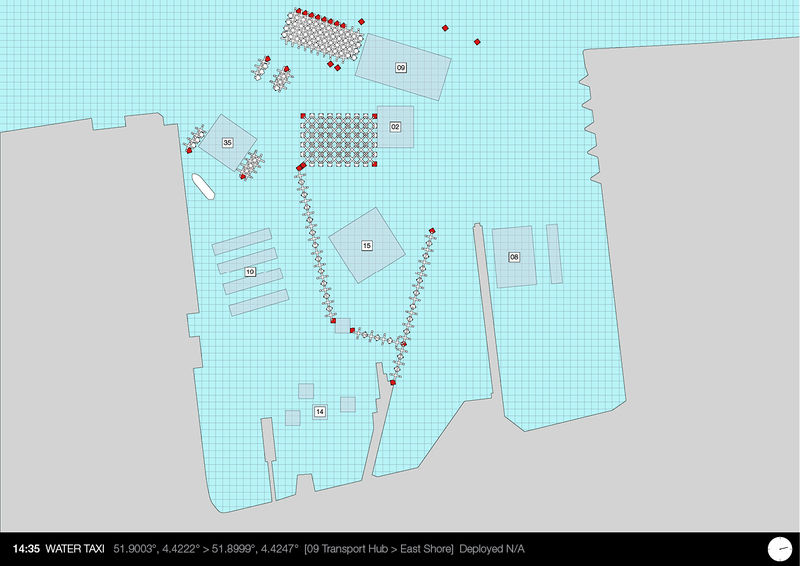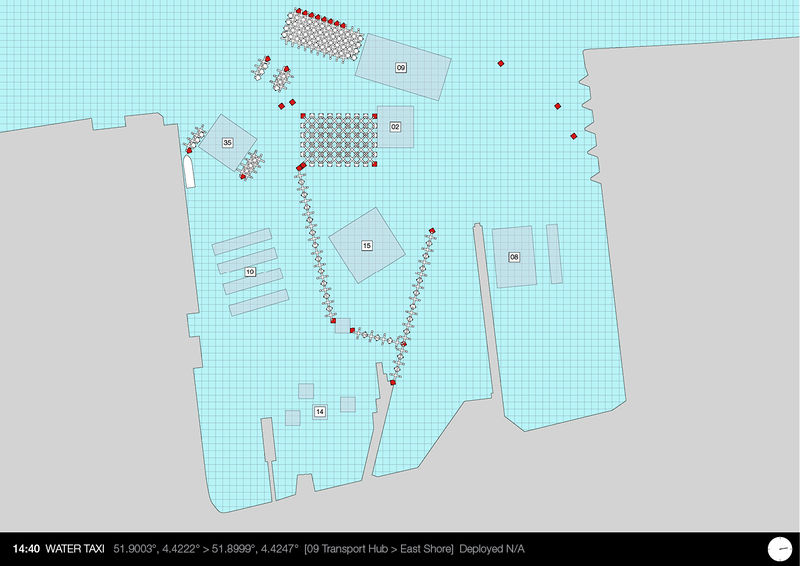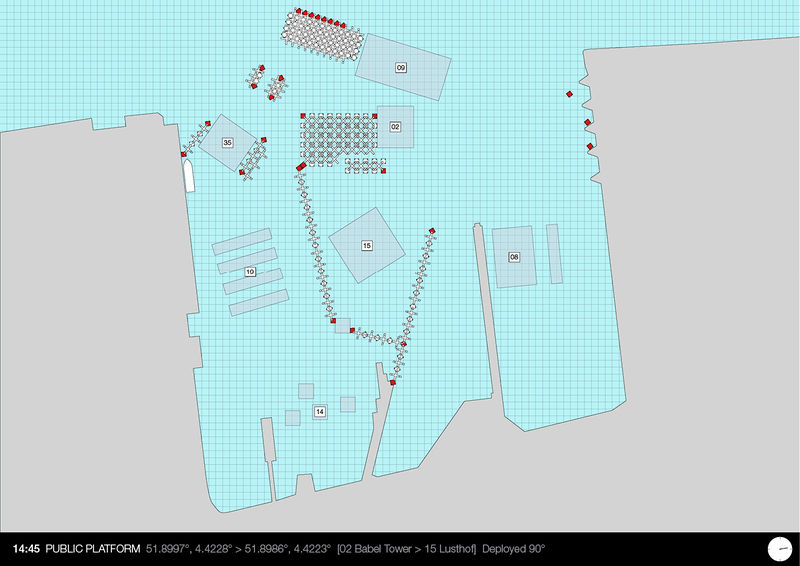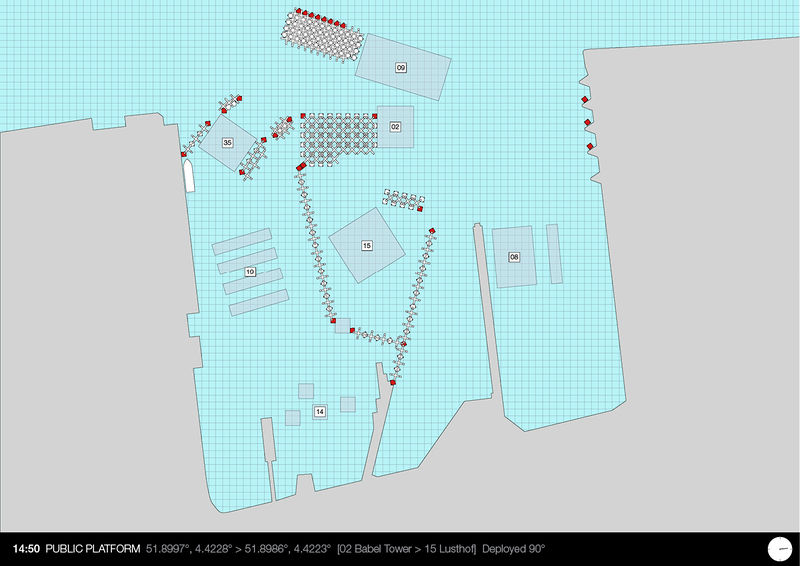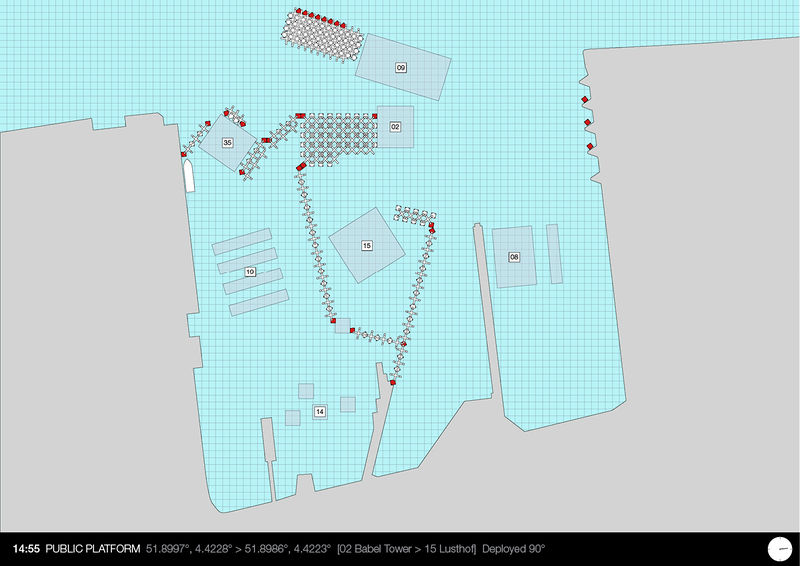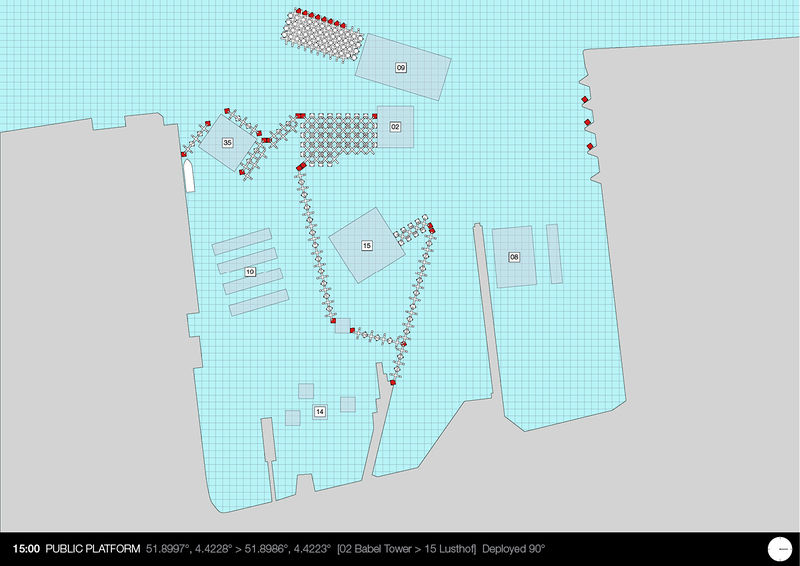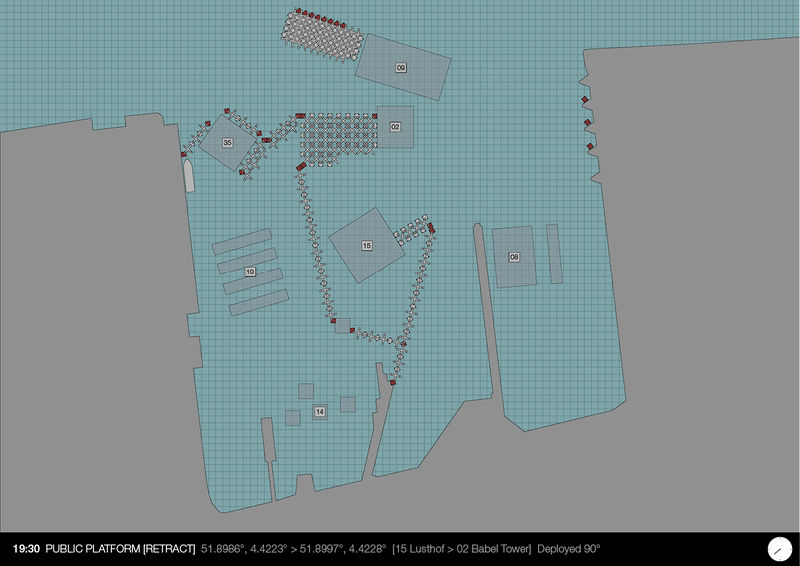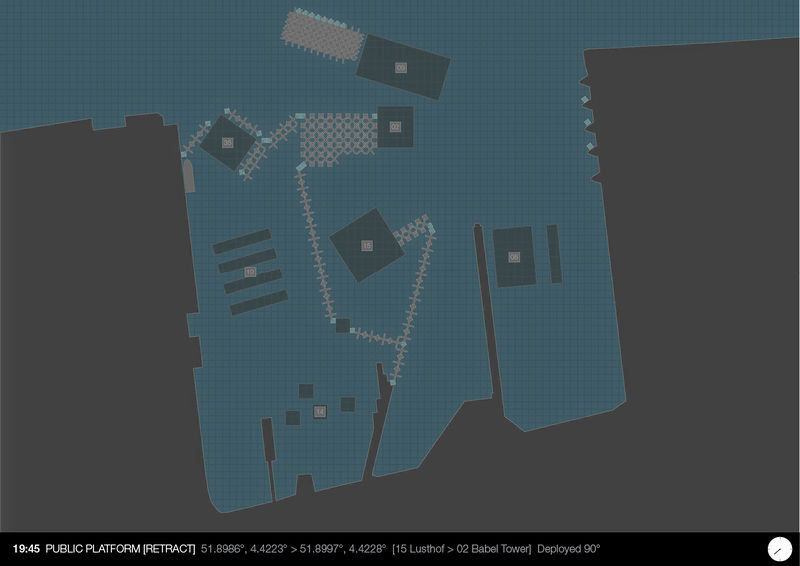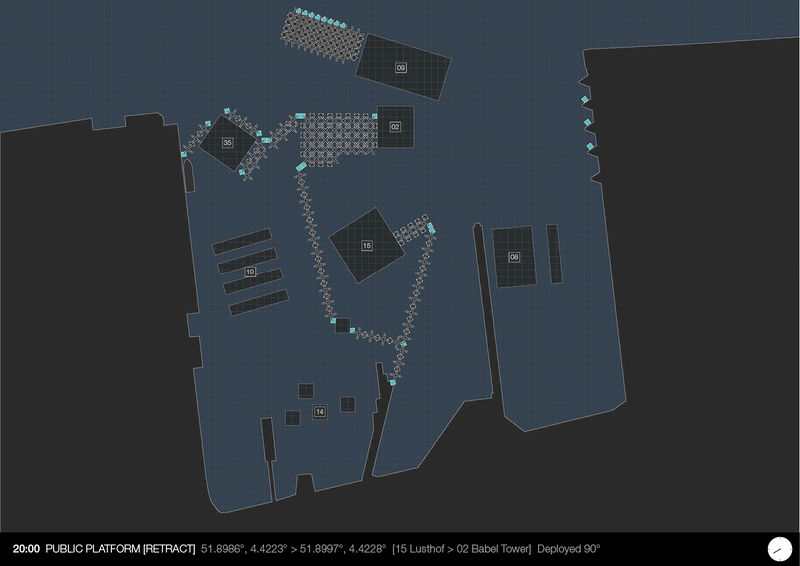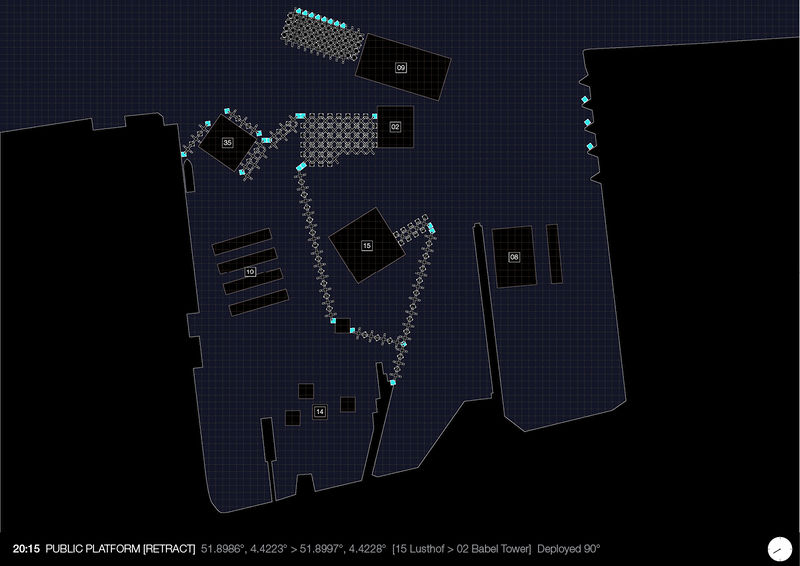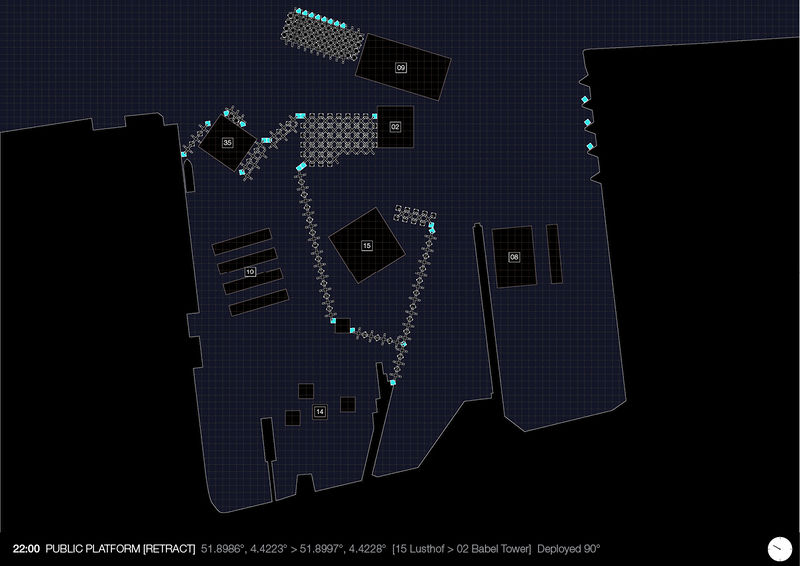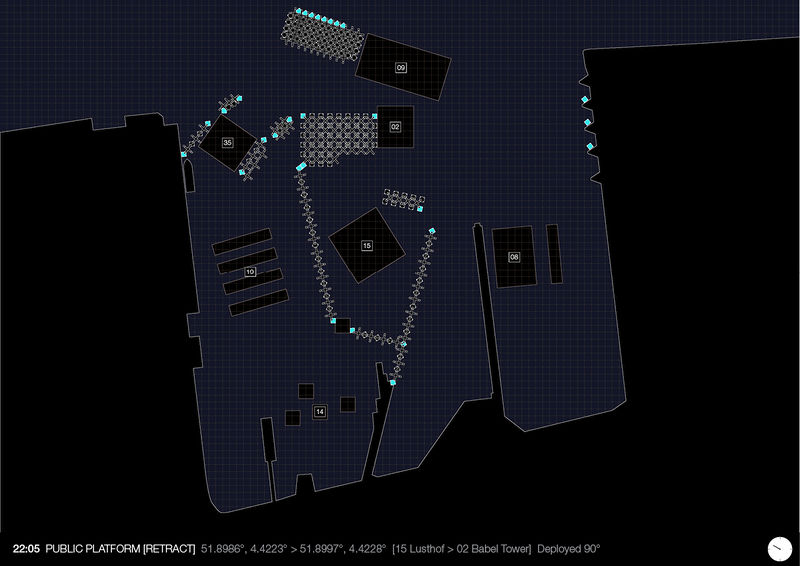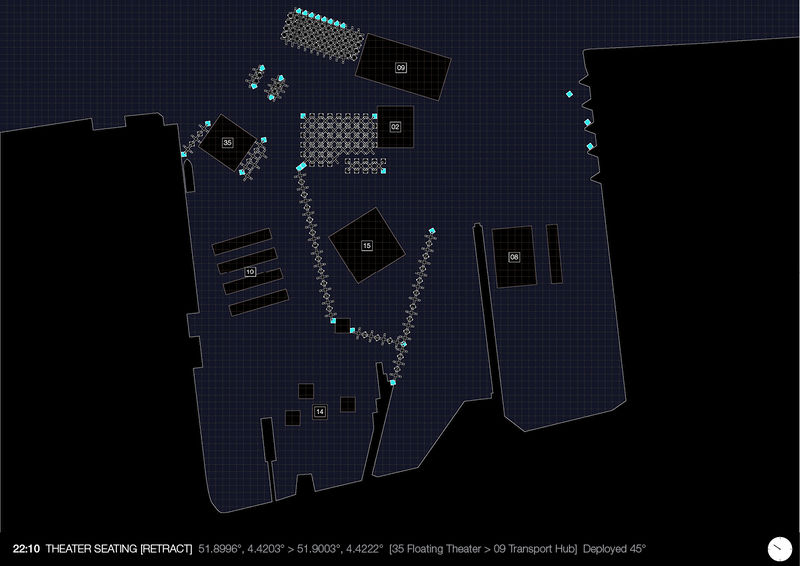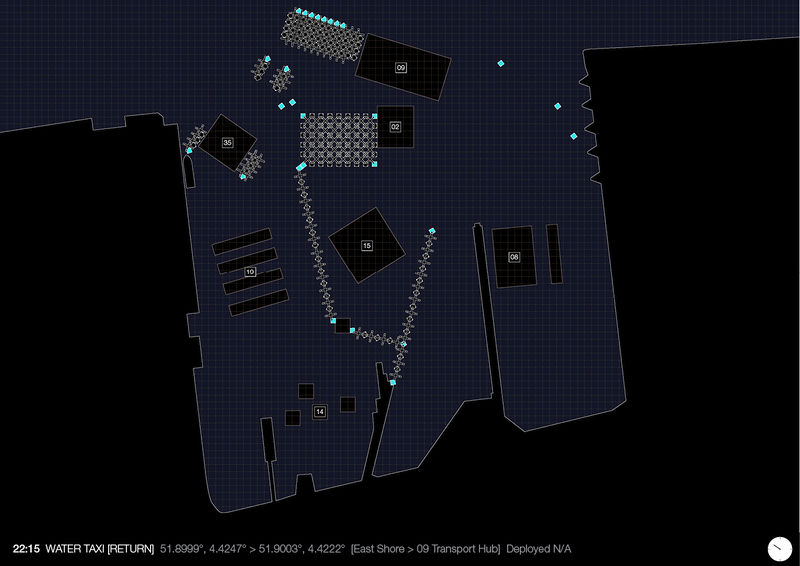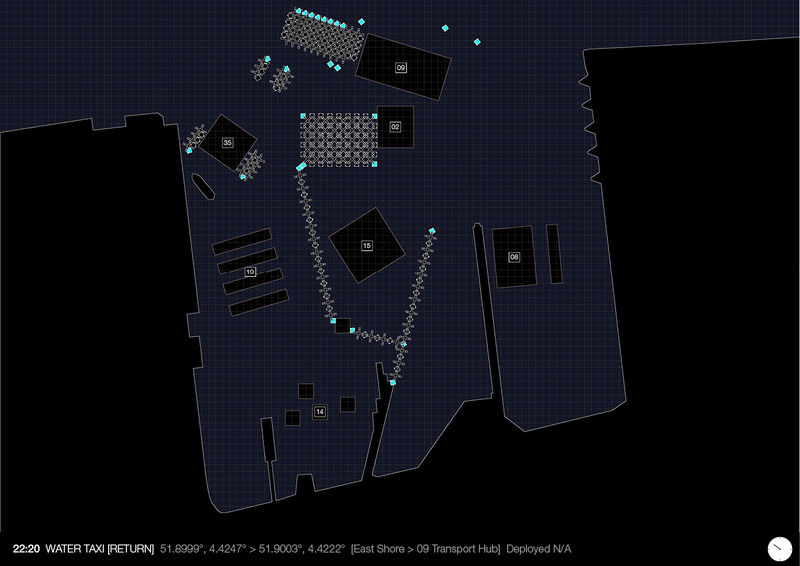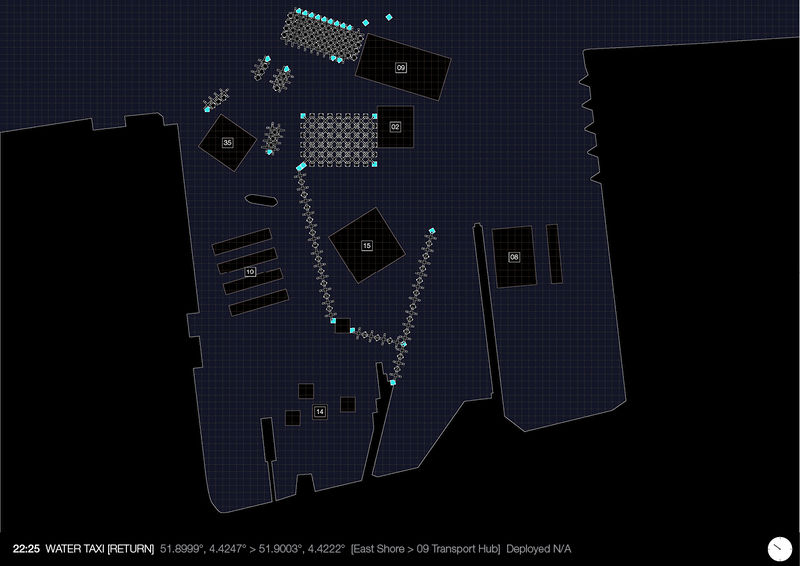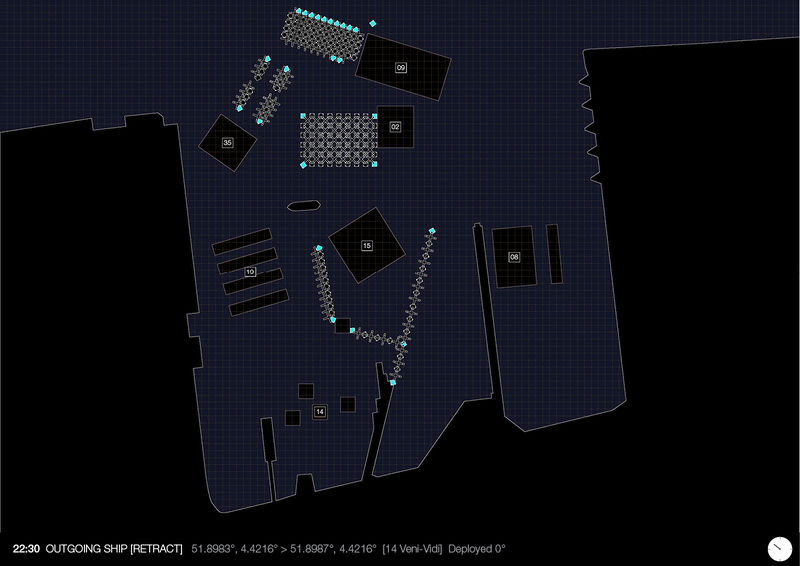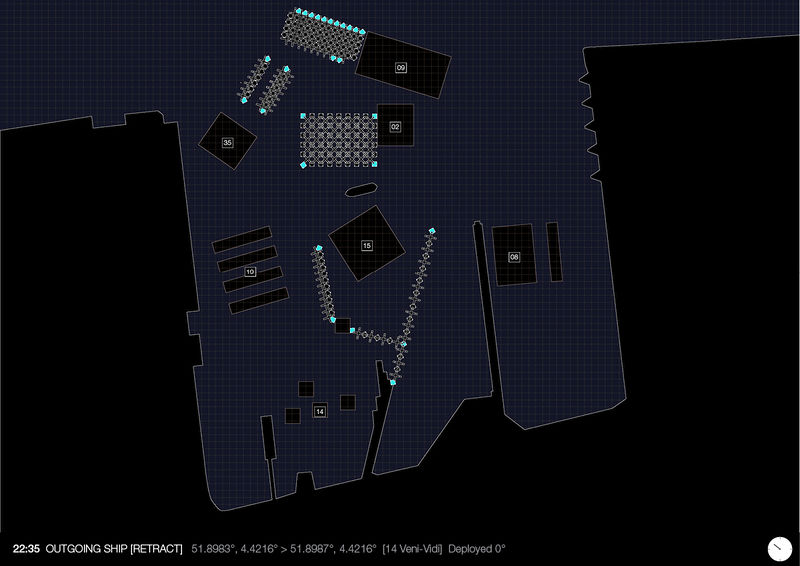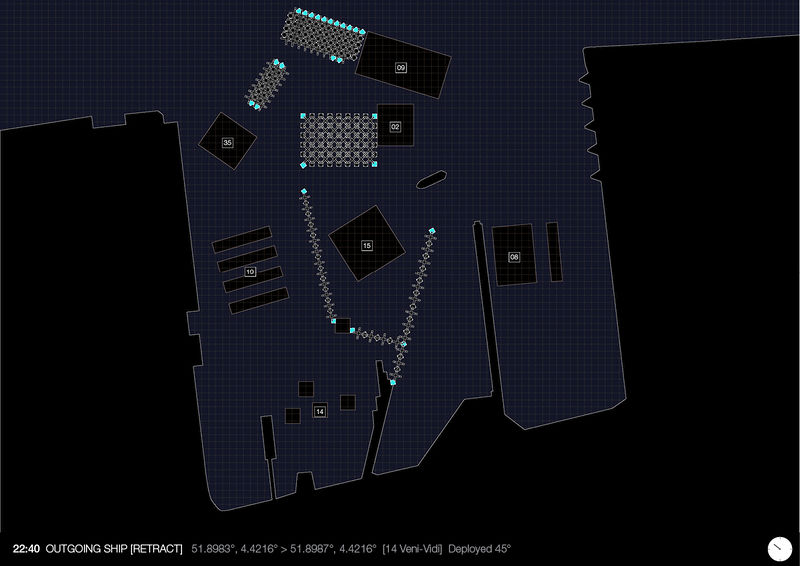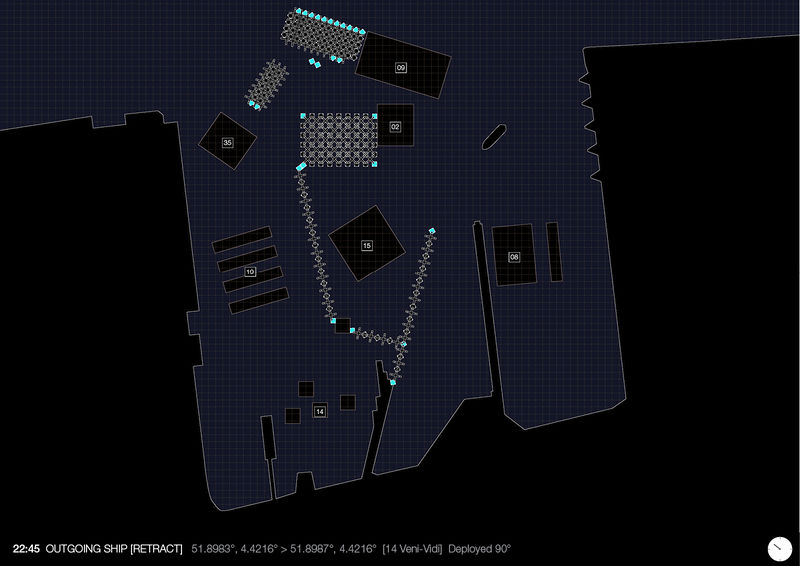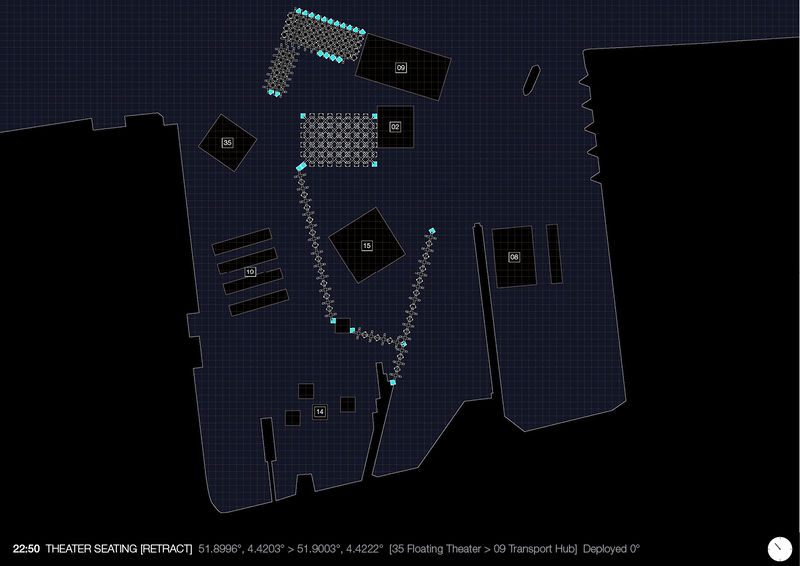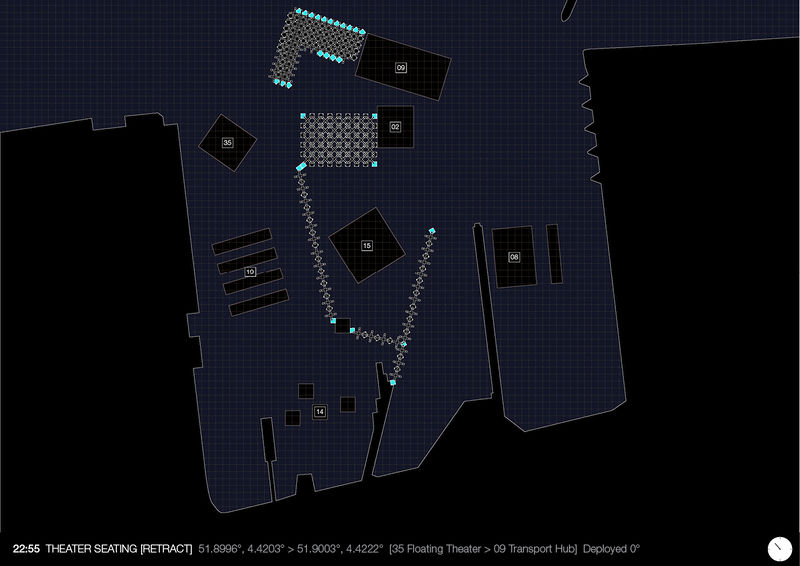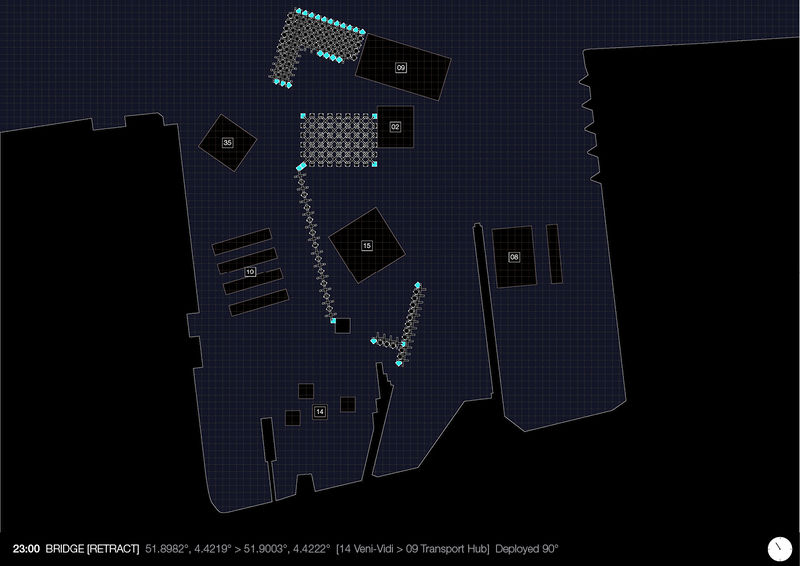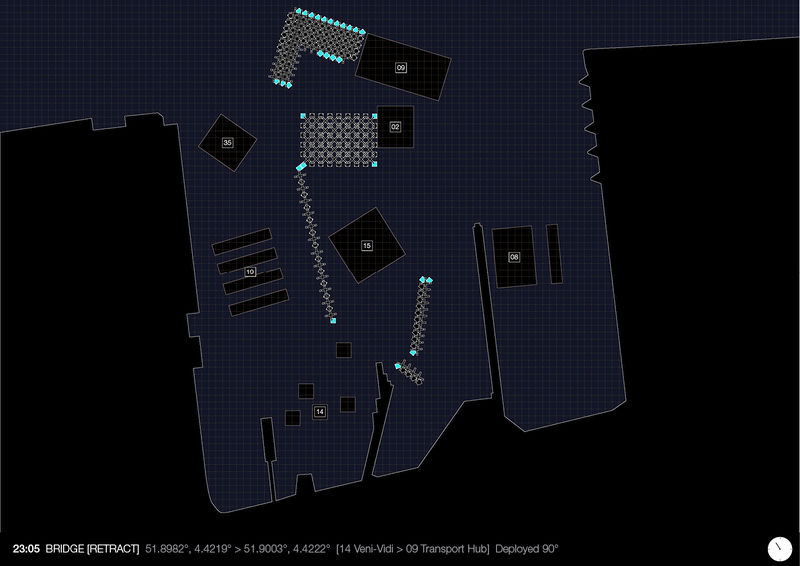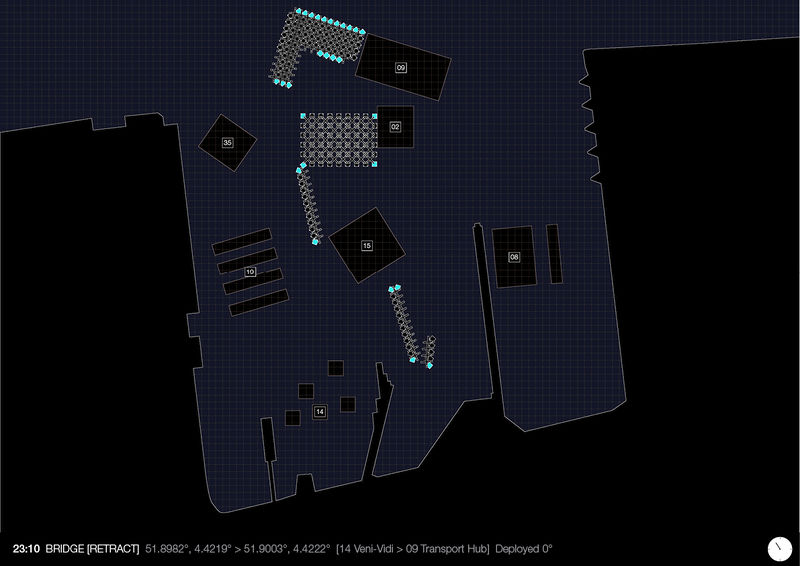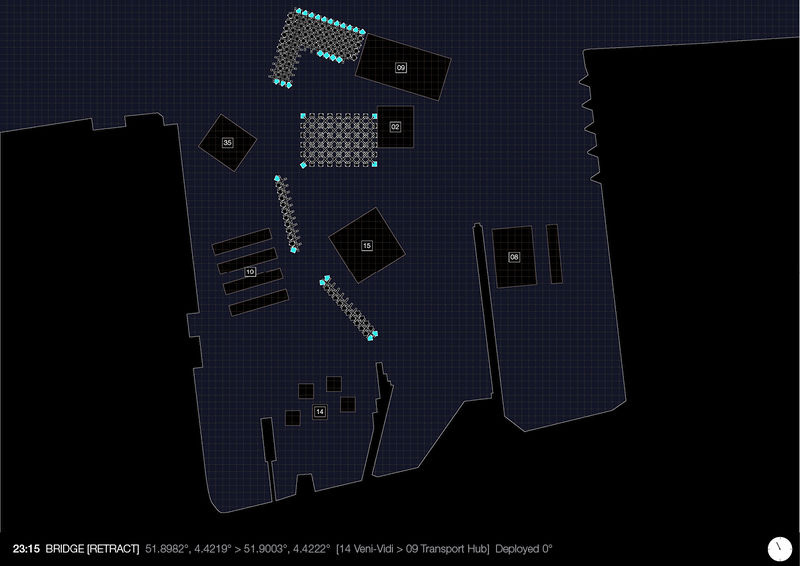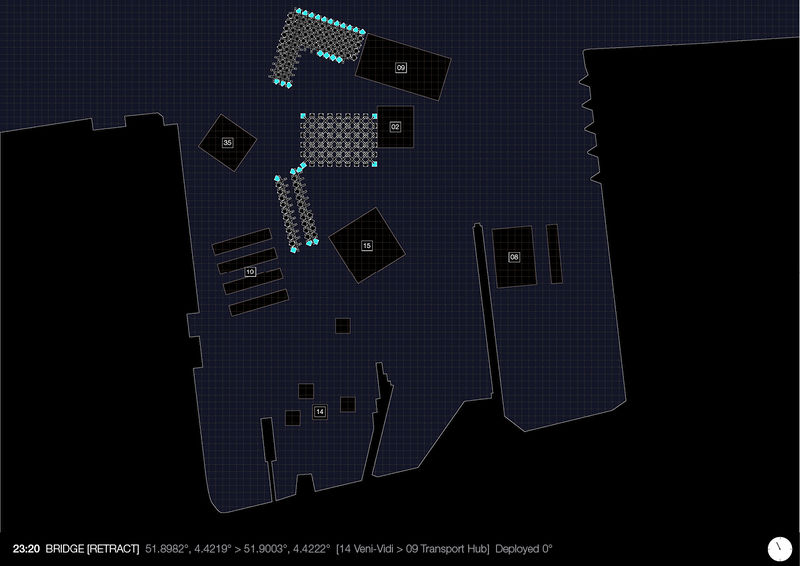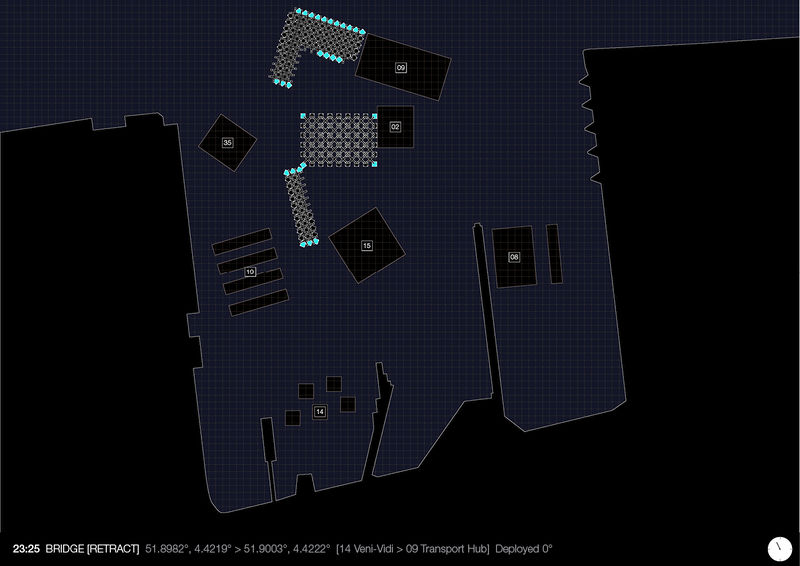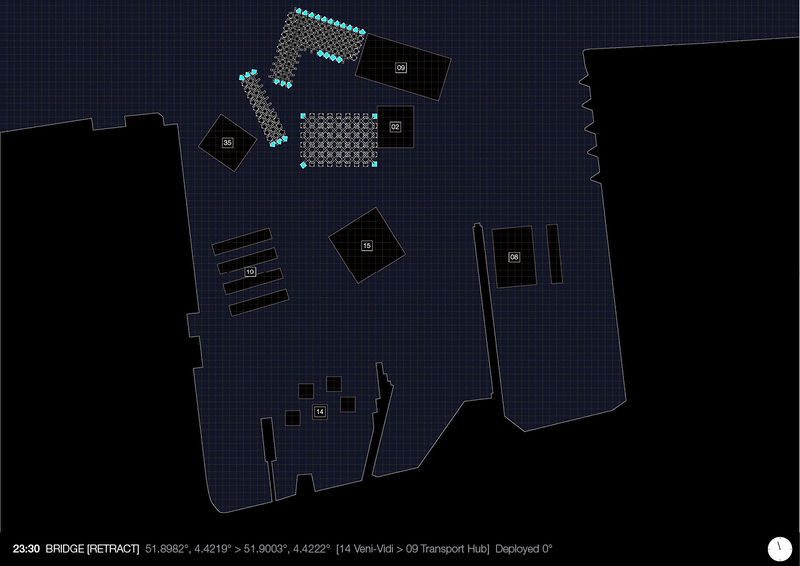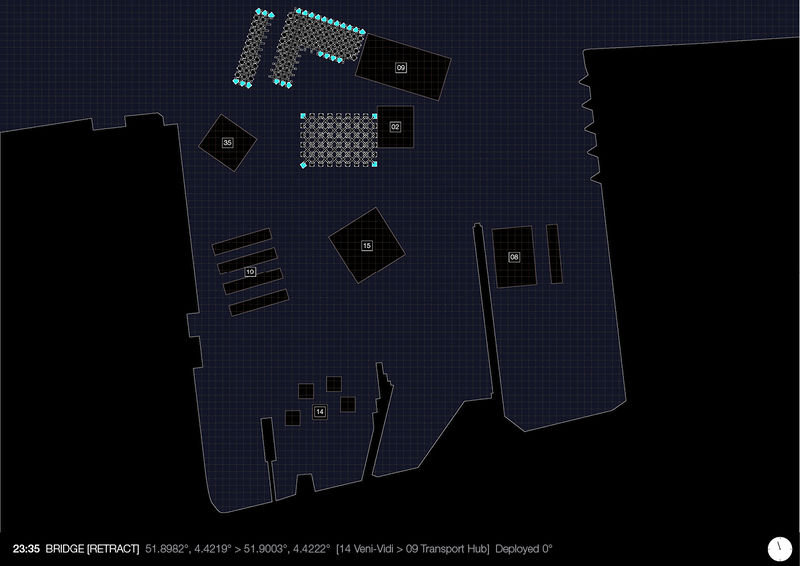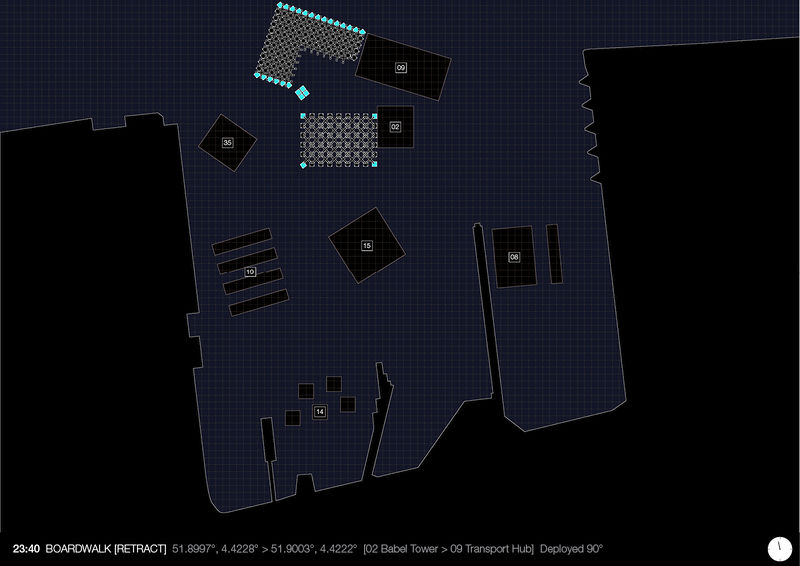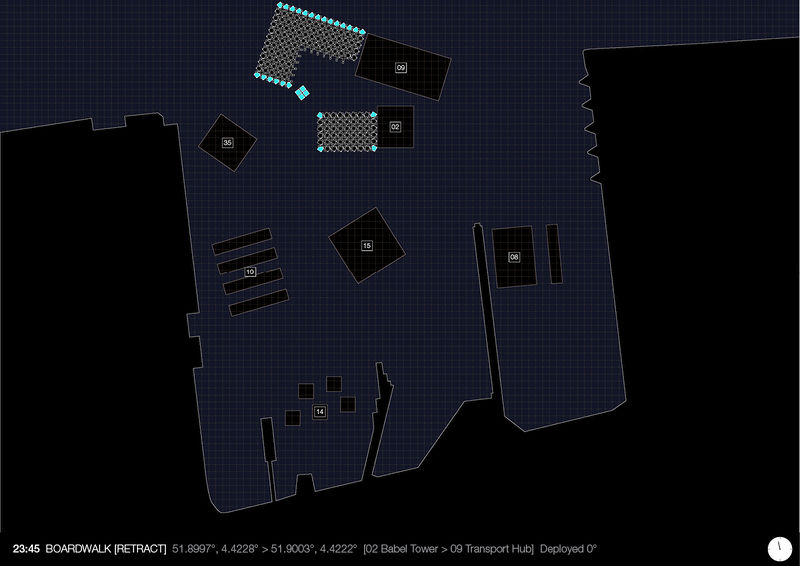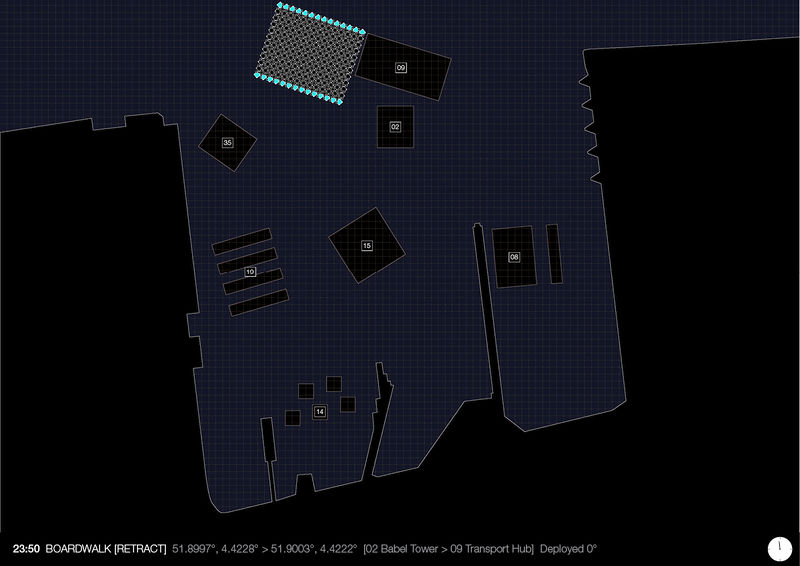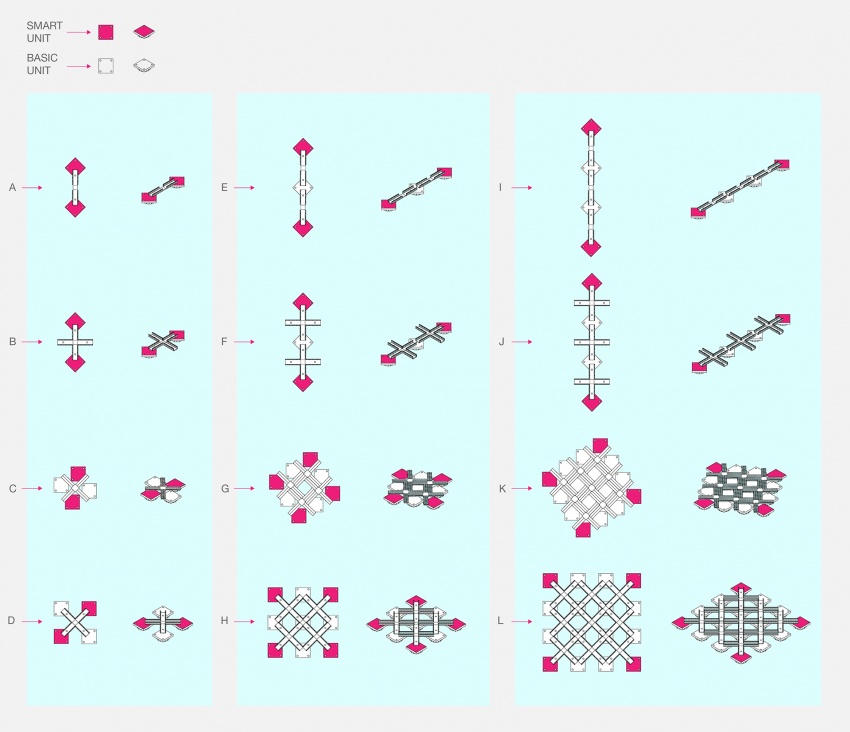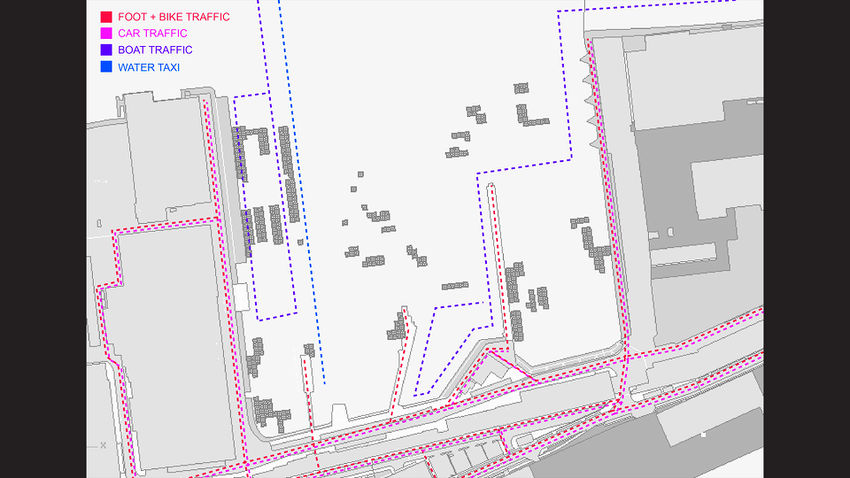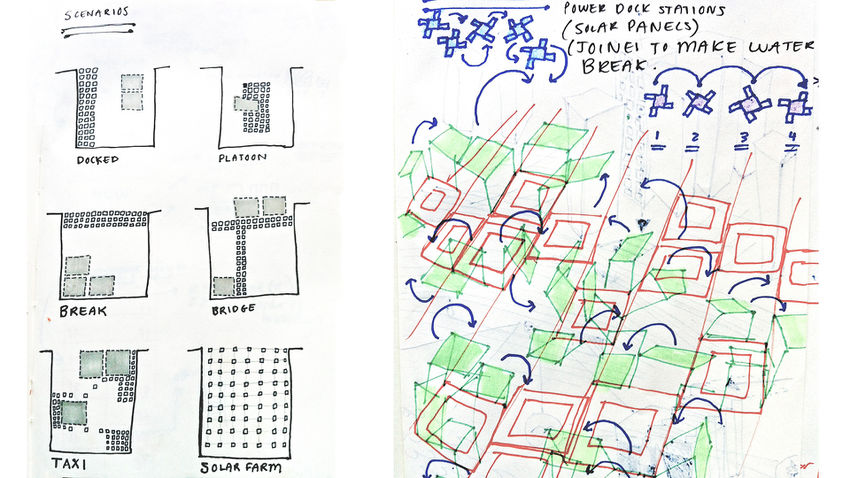project23:Interactions
Contents |
Deployable Bridge Connections
The Deployable Bridge provides platforms to circulate people through a wet environment and forge connections to other projects on or by the water. By offering individual and collective transit anywhere on site, the bridge can be constructed of single units, smaller groupings, or more massive clusters.
The bridge consists of floating square-shaped platform units (◘) and 4-part pathway units (✚). Platform units (◘) are either basic units or smart units (denoted here in red). Smart units are equipped with 4 directional thrusters and the capacity to send and receive information and instructions. Smart units are positioned on all corners of a field of basic units (or on both ends of a line of basic units) to effectively rotate and deploy the basic units. This allows for the freedom of any kind of arrangement and formation according to user needs.
24-Hour Time Lapse: RDM Harbor
This animation provides one possible overview of a 24-hour time lapse of the RDM Harbor site. The functional capacities of the bridge are listed by each time frame, in accordance with different projects located on the site. Different scenarios require different formations, necessitating a wide range of possible surface areas and various speeds for different scales of transit. The bridge can also support other projects by providing additional public platforms, circulation routes, and seating.
== Deployable Bridge: Catalogue of Formations ==
The bridge can be configured to connect projects on-site with any point along the shoreline, or any boat or water taxi on water. The path of the bridge can be defined and reconfigured by users with different needs, allowing users to participate and interact with the transit system in line with personal preferences. Pedestrians no longer need to circumnavigate the harbor on dry land.
Catalogue formations are defined as follows:
A. (2 ◘, .5 ✚, deployed) Bridge Formation (32 m2)
B. (2 ◘, 1 ✚, deployed) Bridge Formation with Docks (32 m2)
C. (4 ◘, 1 ✚, closed) Public Platform (64 m2)
D. (4 ◘, 1 ✚, deployed) Multi-Directional Bridge (64 m2)
E. (3 ◘, 2x.5 ✚, deployed) Bridge Formation (48 m2)
F. (3 ◘, 2 ✚, deployed) Bridge Formation with Docks (48 m2)
G. (9 ◘, 4 ✚, closed) Public Platform (144 m2)
H. (9 ◘, 4 ✚, deployed) Multi-Directional Bridge (144 m2)
I. (4 ◘, 3x.5 ✚, deployed) Bridge Formation (64 m2)
J. (4 ◘, 3 ✚, deployed) Bridge Formation with Docks (64 m2)
K. (16 ◘, 9 ✚, closed) Public Platform (256 m2)
L. (16 ◘, 9 ✚, deployed) Multi-Directional Bridge (256 m2)
RDM Harbor Circulation Map
This diagram depicts pedestrian, bike, car, boat, and water taxi traffic on the RDM site. The Deployable Bridge aims to connect people from all transit modes, by land or by sea, anywhere in the harbour site. The square masses symbolise possible formation scenarios of the units. The bridge can efficiently connect to other floating projects in a multitude of configurations. It can also help other projects circulate people and goods throughout the site, effectively bridging marine life with shore life.
Bridge Formations: Concept Sketches
Preliminary sketches which established a framework for the various formations of the Deployable Bridge.
Additional Connections
(PROJECT:PROJECT) (PROJECT:BUILDING) (PROJECT:OBJECT) (PROJECT:PERSON) (PERSON:PERSON) (OBJECT:OBJECT)
Free-Floating Islands
ISLANDS float freely and have the capacity to regroup and cluster around certain projects according to need. For example, it can connect people to the BABEL TOWER who would like to worship. As a network of connective modules, they also can possess different functions, for example:
- floating solar farm - floating food farm - floating public baths
The great planar area which ISLANDS consumes is optimal to maximize solar harvesting and sun exposure for plants. Think flat and wide-spread.
(PROJECT:OBJECT)
Project 23 (FLEXIBLE WATER TRANSIT) :: Object 17 (Cargo Vessel Shoonerbrig TRES HOMBRES 126 ton)
The sailing general cargo vessel schoonerbrig TRES HOMBRES 126 ton is a ship constructed by Andreas Lackney and the employees and volunteers of the Fair Transport sustainable shipping company.
Flexible Water Transit (AQUATIC TRANSPORTATION) aims to connect all styles of transit to and from the RDM dock. This includes pedestrian, bicycle, car, boat, bus, train, and water taxi transportations. As a network of floating platforms, the aquatic transit modules can connect such boats as the cargo vessel schoonerbrig (Object 17) for repair and docking.
PROJECT:PERSON
Project 23 (FLEXIBLE WATER TRANSIT) :: Person 25 (Captain Andreas Lackner)
Andreas Lackner is one of the three heads of Fair Transport, a sustainable transport company. The company works with Tres Hombres Rum, selling their product at ports worldwide.
Lackner and other such sailors who frequently dock at the RDM pier require a level platform for boat repair and access the the shore. In particular, Lackner deals directly with the port public to sell handcrafted goods. A good connection between sea and land is vital. AQUATIC TRANSIT aims to facilitate easy transit for sailors such as Lackner and locals to interact on water. Additional programs such as farming and swimming can also be provided atop the floating modules.
PROJECT:OBJECT
Object 17 (Cargo Vessel Shoonerbrig TRES HOMBRES 126 ton) :: Person 25 (Captain Andreas Lackner)
Andreas Lackner is the captain of the Cargo Vessel Shoonerbrig TRES HOMBRES. Lackner represents the segment of the local population of RDM harbour which sporadically docks ship for a period of 1 day - 2 weeks. Since numerous vessels as the TRES HOMBRES will be harboured here, the architecture must accommodate such arrivals and departures, in addition to services such as boat repair, sale of goods, and frequent traffic.
